Mark Sisson's Blog, page 264
April 19, 2015
Weekend Link Love – Edition 344
 Today’s the last day to submit your success story and enter to win a year’s supply of the Primal Essentials Kit. Learn more here.
Today’s the last day to submit your success story and enter to win a year’s supply of the Primal Essentials Kit. Learn more here.
Research of the Week
Tylenol blunts positive and negative emotional reactions.
How much exercise do we need to live the longest?
Synovial fluid bubbles cause popping joints.
Researchers just found the world’s oldest (known) stone tools.
New Primal Blueprint Podcasts

Episode 63: Robin Mazumder: Host Brock Armstrong talks with Robin Mazumder, a community builder committed to making healthier, happier, more socially-connected cities.
Each week, select Mark’s Daily Apple blog posts are prepared as Primal Blueprint Podcasts. Need to catch up on reading, but don’t have the time? Prefer to listen to articles while on the go? Check out the new blog post podcasts below, and subscribe to the Primal Blueprint Podcast here so you never miss an episode.
PaleoFX Kicks Off on April 24 and You Can Livestream It For Free
How Much Sugar is Recommended Per Day?
How to Raise Creative and Self-Reliant Free Range Kids
Interesting Blog Posts
Sarah Fragoso has just launched her new site. Everyday Paleo lives on, but the new site gets a bit more personal.
The “ancestral gut biome” story is getting more complicated.
Distraction as “obesity of the mind.”
Media, Schmedia
The free range parents from Maryland who had a run-in with Child Protective Services in February after letting their kids walk alone to the park (and wrote in to MDA) just had another incident. This time, CPS held their kids for hours without telling them.
“Human beings are not programmed for abundance”: how therapeutic fasting could help solve many of our health issues.
Everything Else
The path to progress for Saudi women includes regular CrossFit workouts.
All I can think of is how awesome this would be for straining broth.
Men wear high heels for the first time.
Recipe Corner
Got a pressure cooker? Make this mocha-rubbed pot roast today.
Caramelized Brussels sprouts with lime and crispy shallots will make any avowed sprouts-hater change their tune.
Time Capsule
One year ago (Apr 20 – Apr 26)
The Dark Side of Dark Chocolate – Even though we all love dark chocolate, there are some concerns to consider.
7 Things You Had No Idea Gut Bacteria Could Do – From vitamin production to neurotransmitter manufacturing to bone fortification, our gut bacteria stay quite busy.
Comment of the Week
I’m the least competitive person I know, therefore I win.
– Yep. That’s how you do it, folks.




April 18, 2015
Fluffy Blueberry Pancakes
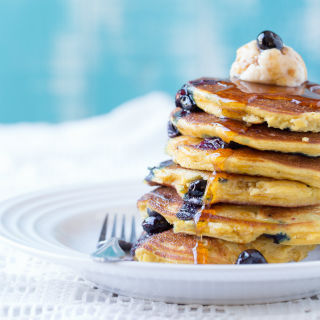 This is a guest post from George Bryant, New York Times best-selling author of
The Paleo Kitchen
and founder of CivilizedCavemanCooking.com.
This is a guest post from George Bryant, New York Times best-selling author of
The Paleo Kitchen
and founder of CivilizedCavemanCooking.com.
Pancakes, they were my favorite comfort food as a child and then turned into an enabling food for my bulimia. After overcoming my 12-year struggle with bulimia, I realized it was empowering to reintroduce some old comforts and eat them in a healthy space relating to food.
After that realization, I dove right in to start creating the perfect Paleo Pancake that looked, tasted, and cooked just like traditional pancakes and we nailed it. This was my favorite recipe to retest a few times to make sure it was perfect. Honestly, it was always perfect but I wanted more reasons to photograph it again and of course eat them.
The photo I got of these pancakes really is my favorite photo I have ever taken, I want to get it framed.
Since The Paleo Kitchen has taken off in popularity, we have been getting tons of comments and emails on the best way to have these pancakes. The crowd favorite is chocolate chips and some close others are strawberries, almond butter and then using them to make ice cream sandwiches.
Now it is your turn to make these pancakes and get as creative as your taste buds desire. Without further taste bud torture, here is the recipe:
Servings: 5 pancakes
Prep time: 5 minutes
Cook time: 15 minutes
Ingredients:
3 large eggs
1/2 cup (120 ml) + 3 tablespoons almond or full-fat coconut milk
1 tablespoon organic honey
1/2 tablespoon freshly squeezed lemon juice
1 teaspoon vanilla extract
½ cup (60 grams) coconut flour
½ cup (65 grams) tapioca flour
1/2 teaspoon baking powder
1/2 teaspoon baking soda
Pinch of fine-grain sea salt
Coconut oil, for greasing the skillet
1/2 cup (75 grams) fresh blueberries
Coconut Butter, for serving
Maple syrup, for garnish (optional)
Instructions:
In a large bowl, whisk the eggs. To the eggs add the almond milk, honey, lemon juice, and vanilla and whisk until well blended. In a separate bowl, mix together the coconut flour and tapioca flour, then add to the wet ingredients 1/4 cup (60 grams) at a time, while continuously whisking. Then mix in the baking powder, baking soda, and salt.
Grease a large skillet and place over medium heat. Once the skillet is hot, use a ladle to pour 3-inch (7.5-cm) pancakes in the skillet. Once holes begin to appear in the surface of a pancake, drop a small handful of blueberries onto it and flip it. The pancake should cook on each side for 3 to 4 minutes. Repeat with rest of the batter.
Top with coconut butter and enjoy!
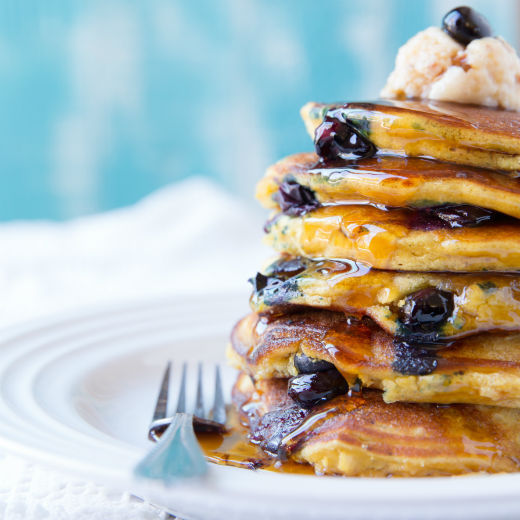
Not Sure What to Eat? Get the Primal Blueprint Meal Plan for Shopping Lists and Recipes Delivered Directly to Your Inbox Each Week



April 17, 2015
I Think Grok Would Be Proud
It’s Friday, everyone! And that means another Primal Blueprint Real Life Story from a Mark’s Daily Apple reader. If you have your own success story and would like to share it with me and the Mark’s Daily Apple community please contact me here. I’ll continue to publish these each Friday as long as they keep coming in. Thank you for reading!
 Hi, I’m Fisher, at my heaviest I was about 275 pounds.
Hi, I’m Fisher, at my heaviest I was about 275 pounds.
From the beginning of my life I was always very active. I was always playing sports and my main discipline was martial arts, specifically Taekwondo and Tang Soo Do. Even after I graduated from college I was 150 pounds and a golf professional.
Shortly after I began my career as a golf professional, I became very ill with pneumonia. I went from running three miles a day in 20 minutes and benching twice my weight, to not being able to walk five paces without collapsing. Even after my recovery from the pneumonia, my lungs were still far from working efficiently. I was on the shelf for years. During this time I was eating with no restrictions. Anything was okay, so I soon began to put on the pounds.
Once I realized I had a serious weight problem, I tried to exercise again. The pneumonia scarred my lungs pretty badly and I had started smoking. I couldn’t run fast, nor long, but I trotted for a mile three days a week, then lifting for 30 minutes on the days I wasn’t running. I went with CW low fat and kept everything else normal. I did lose weight, but I was stalling at a weight that was still unhealthy. So, I picked up my training and started running longer, lifting heavier, and yet still couldn’t lose the unwanted body fat.
So CW tells me to restrict my calories and really reduce my fat intake. Again, I lost weight but felt weaker and still had the body fat. So I picked up my training again this time using HIIT and density training methods. I felt tired, started to get injured, and still had the body fat! I started to think I was just genetically flawed or had ruined my metabolism some how. My work ethic was relentless and I trained through the injuries, but I stalled. No changes except I was feeling old! I then started to track every calorie, every macronutrient and monitored every meal. Which by the way, I do not regret. It really taught me a lot and started my fascination with nutrition.
I stumbled upon Mark’s Daily Apple about eight months ago. I found the information to be amazing! Especially since I’d already learned by trial and error that conventional wisdom was not so wise. I kept seeing these references to Grok. I was thinking who is this Grok guy they keep talking about.. Haha.. So, I purchased the book. For me, this book was confirmed how I was feeling through my years of trial and error. It finally clicked. I’d finally seen all the proof I needed.
I’ve now been living grain free, hydrogenated vegetable oil free, and sugar free for roughly four months. My body fat is at 8.2%, my energy level is through the roof, and I’ve never been more happy in my life.
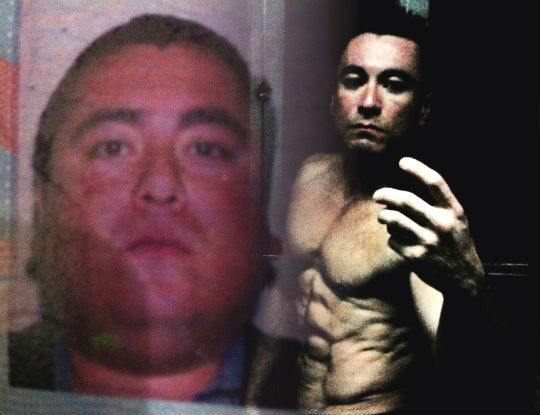
I’m currently working and living in China. Getting around rice, noodles, and dumplings is certainly challenging and very confusing for people when I have dinner with them! I try to cook every meal and if I do eat out I tend to choose a sushi bar. All the restaurants cook with peanut or sunflower oil so I stay away from the restaurants. I use lard as my cooking oil since coconut oil and other healthy oils are nowhere to be found. I think Grok would be proud and would love my “Primal Chinese style” cooking! I use a lot of stir-fry method cooking and boiling. My macros per day are around 140 grams of fat, 180 grams of protein, and 50 grams of carbs coming from usually broccoli, spinach, mushrooms, and the occasional sweet potato. Once I went primal, my body fat reduced from 14% to 8.2%. That might not sound like much but it’s huge for me. And I did nothing different, except completely eliminate grains and unhealthy oils. Besides my body being in top condition, my mind is so clear, my energy is limitless, and I’m truly happy. My mental and physical health are the best it’s ever been. However, I’m by no means satisfied. I’m always in a state of progression and I keep learning about my body everyday.
 My life has changed drastically in the last 5 years. From being a mortgage broker in Las Vegas, 275 pounds, depressed, and angry… Now, I’m a fitness and nutrition consultant in China. Spreading the word of sound nutrition and exercise. I’ve opened a personal training studio where I can train with people one-on-one without the judgement that comes with being a newbie at most gyms. I help my clients learn about macro nutrients and the importance of whole foods. My business is so successful now after a short few months, that I’ve now started group classes at some of the universities in my city. I’m starting a strong healthy family in China.
My life has changed drastically in the last 5 years. From being a mortgage broker in Las Vegas, 275 pounds, depressed, and angry… Now, I’m a fitness and nutrition consultant in China. Spreading the word of sound nutrition and exercise. I’ve opened a personal training studio where I can train with people one-on-one without the judgement that comes with being a newbie at most gyms. I help my clients learn about macro nutrients and the importance of whole foods. My business is so successful now after a short few months, that I’ve now started group classes at some of the universities in my city. I’m starting a strong healthy family in China.
I’ve never been more satisfied with my work. Waking up everyday is a joy and can’t wait to get to the office. It’s been a challenge though, speaking Chinese about biology, food science, and anatomy is a struggle!
For those of you just starting your journey to better health, my advice to you is take it one day, one meal at a time. If you can’t change all your foods at once, eliminate one at a time. Preparation is key! Knowing my office is surrounded by KFC and unhealthy restaurants, I cook my lunch in the morning when I’m making breakfast and take it with me.
When you train, train with purpose. I’ve accepted the fact that I’d rather be in top physical and mental shape, than have a food that comforts me and does nothing for my body. Stay focused and trust the lifestyle. Let all the doubters keep doubting. Once they see you transform maybe then they will wake up. I wish you all good luck and good health!

Fisher




April 16, 2015
Paleo f(x) Kicks Off on April 24 and You Can Livestream It for Free
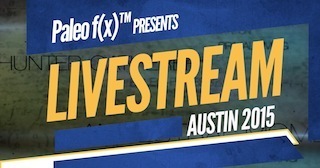 One of my favorite events of the year is Paleo f(x), the world’s largest paleo gathering. Folks from around the globe gather in downtown Austin to celebrate the ancestral health movement and learn from health and fitness pros who have dedicated their careers to promoting Paleo/Primal principles.
One of my favorite events of the year is Paleo f(x), the world’s largest paleo gathering. Folks from around the globe gather in downtown Austin to celebrate the ancestral health movement and learn from health and fitness pros who have dedicated their careers to promoting Paleo/Primal principles.
I have had the honor of participating in past Paleo f(x) events, and I have the pleasure of doing so again this year, at Paleo f(x) 2015 from April 24-April 26th at the Palmer Events Center in Austin, Texas.
I invite you to join me in this Paleo immersion, where we’ll explore in-depth this new wave of nutrition, fitness, and preventive healthcare that incorporates a holistic lifestyle, functional fitness, and “Real Food” nutrition. Paleo f(x) speakers will explore my favorite Primal topics, including:
Adopting a lifestyle based on whole food nutrition
Practicing optimal functional fitness
Promoting sustainability
Encouraging humane food & farming methods
Cultivating a healthy relationship with nature
Pursuing happiness in all your health & wellness endeavors
It’s three jam-packed days of presentations, Mastermind panels, discussions, Think Tanks, cooking demonstrations, and hands-on fitness workshops led by leading physicians, scientists, New York Times best-selling authors, athletes, fitness professionals, and activists.
I’ll have a booth set up (as will hundreds of other Paleo-friendly vendors) so come by and shake my hand if you’re at the event—I’d love to meet you! They’re expecting more than 2,500 people to show. It should be a good mix of newbies and veterans.
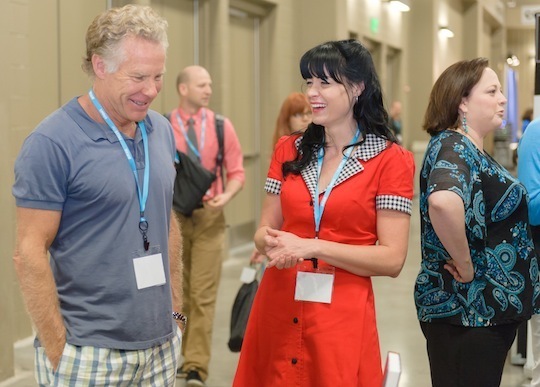
If attending Paleo f(x) isn’t an option for you this year, then no worries. Paleo f(x) is all about promoting the movement and reaching as many people as possible, so the organizers are offering the event for FREE via livestream from April 24-26th.
Free? Yes! You can livestream all presentations on the Prescript Assist Paleo On Ramp stage (everything you want to know about health, nutrition, fitness, sleep, and lifestyle from an evolutionary health perspective) and Amara Cooking stages (featuring dozens of cooking demonstrations from top Paleo foodies). Just register now, and then watch for free on April 24-26th.
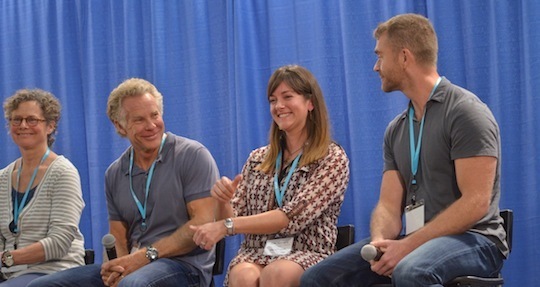
Be on the lookout for my keynote address on April 24th at 3:45 pm, and my panel discussions on April 24th at 10:00 am and 1:30 pm, and April 25th at 10:00 am and 4:50 pm. (All times are in CDT.)
Here’s the low-down on what we’ll be discussing:
April 24th at 3:45 pm: Tweaking the Recipe to Build an Awesome Life
In my keynote presentation I will be revealing the ways in which I have adjusted and adapted my own lifestyle from my original Primal stance ten years ago in order to optimize health and maximize my enjoyment of life. It’s an “intermediate” level presentation, but don’t let that deter you if you’re new to the movement. Learning how to “adapt or get dropped” is essential no matter where you are in your primal journey.
April 24th at 10:00 am: The Robb & Mark Show
Robb and I answer your questions on all things Paleo, bouncing ideas and witticisms off one another as we go. It’s a Paleo f(x) tradition!
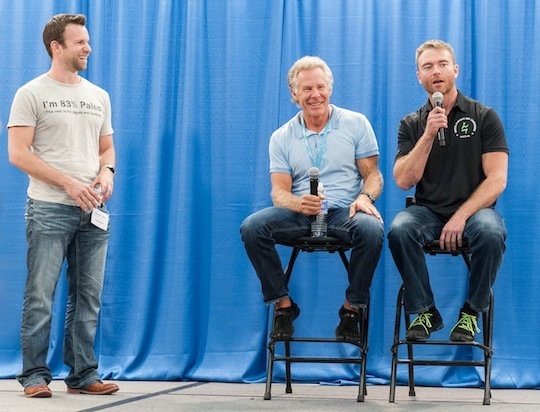
April 24th at 1:30 pm: State of the Paleo Union Address
Robb Wolf, Diana Rogers, Chris Kresser, and Dallas Hartwig will join me for an inspiring look at the past, present, and future of Paleo.
April 25th at 10:00 am: Building, Not Burning, Bridges in the Paleo Movement
This panel discussion explores community building, and how to best foster relationships with others in the real food community, like local activists and even (gasp!) vegans.
April 25th at 4:50 pm: Don’t Let the Perfect Get in the Way of the Good
Alongside thought leaders Nina Teicholz, Jen Sinkler, Emily Schromm, and Kyle Brown, I break down perfectionism, and how to not let it stand in the way of your health and wellness progress. It’s the perfect panel for the Paleo beginner or the experienced enthusiast looking to bust past plateaus.
Register for the Livestream Event and gain access to not only my discussions, but also those of other Paleo experts featured on the recent Greatists list of the Top 100 Health Influencers, including Robb Wolf, Chris Kresser, Jen Sinkler, and Dave Asprey. Whether you join us in-person or via livestream, it promises to be an event to remember and hopefully a highlight of your year!
Register for the FREE Paleo f(x) Livestream Today>>



April 15, 2015
How Much Sugar Is Recommended Per Day?
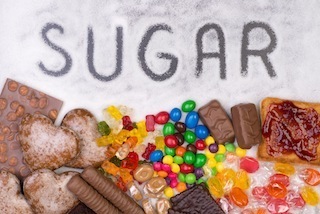 By now, American exceptionalism is a universally-accepted truism. Like dogs over cats and Star Wars over Star Trek, it’s simple fact that America is qualitatively different than other nations. Some would say “superior,” but I think modesty is more becoming of a nation of our stature, providence, and history. Why else would extraterrestrials decide to land on the White House lawn, as they do in every culturally relevant piece of sci-fi, if we weren’t exceptional? Would American parents everywhere claim their kids were special if they actually were not?
By now, American exceptionalism is a universally-accepted truism. Like dogs over cats and Star Wars over Star Trek, it’s simple fact that America is qualitatively different than other nations. Some would say “superior,” but I think modesty is more becoming of a nation of our stature, providence, and history. Why else would extraterrestrials decide to land on the White House lawn, as they do in every culturally relevant piece of sci-fi, if we weren’t exceptional? Would American parents everywhere claim their kids were special if they actually were not?
But perhaps the most conclusive evidence of our exceptionalism lies in how our nutritional labels relay information about sugar. If you go to a place like Germany or the UK and flip over a package of Haribo Goldbären (gummy bears), it’ll tell you how many percentage points the sugar in the candy counts toward your daily limit. Point being: everyone else has an upper limit for sugar consumption.
But the US? We have no upper limit on sugar. And when it comes to added sugar, it’s a total free for all. It’s not even listed.
Researchers are still uncovering the mechanisms, but it appears that Americans benefit from an epigenetic resistance to the negative effects other nations experience from excessive sugar consumption. My pet theory? The confluence of high-fructose corn syrup subsidies, kids filling up Super Big Gulp cups with Slurpee when the clerk’s not looking, and Wilford Brimley diabetes commercials have converged to create a morphogenetic field of extreme sugar tolerance. Whether it’s a developing fetus or a South Asian migrant, the morphogenetic field envelops and affects everyone within the US. borders. In fact, there’s no such thing as “excessive sugar consumption” in the United States. It’s quite literally impossible to ever reach or even approach the recommended daily limit for added sugar intake because the limit doesn’t exist, physiologically, for Americans. Just flip over that package of Oreos and look at the nutritional label for yourself. American exceptionalism, indeed.
I’m kidding, of course, about the resistance to the damaging effects of excess sugar consumption, but not about the most salient point: there’s no official limit for sugar consumption in the U.S. and in a way, that is exceptional. What’s going on? Well, since sugar’s not an essential nutrient, the Institute of Medicine hasn’t issued a recommended daily allowance (RDA) for it like they have for calcium, total carbs, fat, selenium and all other essential nutrients. They have, however, suggested people get no more than 25% of their calories from added sugar. Yes: 25%. You’d hope the premier health organization in a first-world nation of 300+ million people would have higher expectations for its subjects, but nope. They’re apparently happy as long as you “only” eat about a quarter of your calories as pure white sugar.
It wasn’t always like this. For all its inadequacies, the 1992 US Food Pyramid (remember that?) did suggest no more than 12 teaspoons of sugar for a 2200 calorie diet, or about 10% of calories (PDF). That sounds fairly high to most of you eating Primally, but hey: at least they recommended a limit (and at least it was less than 25%).
Most other governments and health agencies (even the ones in the US) recommend saner limits. In 2002, the World Health Organization polled European countries (PDF) with dietary guidelines:
Many countries had 10% of calories as their limit for sugar, including Finland, Iceland, Norway, Sweden, Macedonia, Denmark, and Malta.
In Portugal, official dietary recommendations suggested limiting added sugar to 20-30 grams per day.
Turkish officials suggested 30 grams for women and 40 for men, or 10% of total calories.
Georgia wanted its citizens eating between 50-100 grams of sugar per day.
Armenia was very precise, recommending that no more than 8.2% of calories come from sugar, and not a tenth of a percent more!
Ukraine said 40 grams a day.
The Czech Republic’s 15 grams per day was the strictest.
The German government suggests no more than 90 grams of sugar, both naturally occurring and added, per day.
Other countries have similar recommendations. India suggests 10% of calories.
Things are moving in the right direction. Just as the people have become more aware of the potential dangers of added sugar, bureaucrats are following suit:
The World Health Organization recommends people obtain no more than 5% of daily calories from added sugar. That’s about 6 teaspoons or 25 grams on a typical diet, and it’s half of what they previously recommended a year or two ago. They’re urging countries to follow suit with national dietary guidelines.
UK’s National Health Service recommends a max of 10% of calories from added sugar and fruit juice. A group of health researchers, though, has recently called on the NHS to halve that.
Even in the US, the recent nutritional panel that recommended the USDA drop the warnings on dietary cholesterol also suggested they implement a suggested limit of 10% of calories as added sugar. As of now, the USDA hasn’t made any changes, choosing to lump added sugar in with “solid fats” (which is as weird a combination as I’ve ever seen) and suggesting we obtain no more than 5-15% of our diet from them.
The American Heart Association gets it, suggesting that men eat no more than 9 teaspoons of added sugar a day. For women, it’s 6 teaspoons. The American Diabetes Association still doesn’t give any concrete sugar intake numbers but recommends against drinking sugary beverages, that most pernicious source of added sugar.
As I see it, the most prevalent recommendation across government agencies and health organizations is “no more than 10% of calories from added sugar.” In the typical 2000-ish calorie diet, that’s 12 teaspoons of sugar, or 55 grams of added sugar per day. That includes:
Any sugar used to make baked goods, candy, chocolate, desserts.
Any sugar used to make sauces, dressings, and condiments.
Honey, HFCS, molasses, agave nectar, white sugar, brown sugar, and any other isolated sugar (I’d say foods like honey and molasses have different metabolic effects than other sugars, but they are added sugars).
Any sugar found in sweetened beverages, including the naturally occurring sugar in fruit juices (most countries consider fruit juice sugar to be added since it’s divorced from its fiber; I tend to agree).
So, 55 grams of added sugar per day. 27.5 grams of fructose. And that’s only if you stick to a 2000 calorie diet.
Few people are actually eating 2000 calories a day. They’re overeating. They’re sitting around. They aren’t using glycogen. They’re walking around (sub-2000 steps a day) with fully replete liver glycogen. And added sugar has very different metabolic effects in a hypercaloric sedentary person with overstocked glycogen — both muscle and liver — stores.
That’s why I much prefer an absolute limit. A liver’s a liver’s a liver. Simply eating more calories doesn’t mean you can safely handle more sugar, nor does it mean your liver suddenly has more metabolic machinery to process and store the fructose as glycogen. If anything, eating higher calorie diets makes you more susceptible to the ravages of sugar, because it then becomes excess sugar. Even the most diehard “anti-fructose alarmist” skeptics will say that the only reason sugar becomes dangerous is when its in excess.
Well, folks: sugar is often in excess of calories. I hate to say it, but it’s true. Just look at the global numbers.
America sits atop the pack with 126.4 grams per day. Way to go, guys! Looks like we’re taking the IOM’s recommendations to heart.
Germany’s next with 102.9 grams a day.
The Netherlands does 102.5 grams.
Ireland follows with 96.7 grams.
The bottom five are Ukraine, China, Indonesia, Israel, and India with 17.1, 15.7, 15.2, 14.5, and 5.1 grams of added sugar per day, respectively. Judging from this study of sugar intake, diabetes, and obesity in India, I’m not sure how reliable any of these figures are, though.
If we take the numbers at face value, just 27 countries attain the 55 grams per day (again, assuming an approximately 2000 calorie diet) recommendation.
I’m curious to hear your thoughts, everyone. Sugar has experienced a bit of a renaissance of sorts in the health community’s consciousness. While I agree that freaking out over a little sugar in your coffee is crazy, and fruit and even honey and other unrefined sources of sugar can be healthy parts of a reasonable diet, I worry about the unrestricted and flagrant use of sugar.




April 14, 2015
Contest: Share Your Success Story
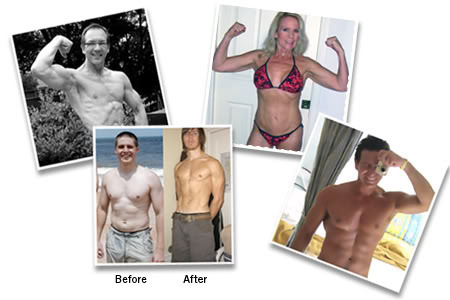
Weight lost, muscle built, complexions cleared, even meds kicked. You know who you are. You’ve gone Primal and you’re better off for it. Now’s the time to share it! This means you have the opportunity to show the rest of the community who you are and what you’ve accomplished. In the process you’ll inspire thousands of people to take control of their health just as you have. I don’t know about you, but I get a kick out of that.
So for today’s special contest I want to hear your story. Write it up and include a photo. Including both pre-Primal and post-Primal pics is even better, but not required. Don’t worry if you’re not a chiseled Adonis. This isn’t a “who’s the most ripped” contest. Whether you’ve lost 100 pounds over two years of Primal living or you’ve simply managed to kick that diet Coke habit, just tell me what going Primal has done for you. I’m looking for interesting and personal tales. Details about your health history, how you found MDA and the Primal Blueprint, what has worked and what hasn’t, what you eat, how you workout, what differences you’ve seen in how you look and feel, and anything else you think readers might be able to learn from and you’re open to sharing are welcome. It doesn’t have to be a thousand word diatribe, but hopefully more than a couple paragraphs. Feel free to be creative with your story format, too. Remember, good stories usually have a beginning, a middle, and an end, and honesty is king.
I’m sure many of you have thought about sending your story in, but just haven’t gotten around to it. There is no better time than now. I’ll be featuring reader stories right here on Mark’s Daily Apple every Friday as I have done for years, as long as you keep sending them in!
The Prize
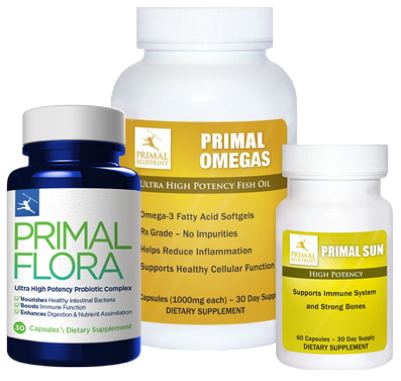 A 1-year supply of the Primal Essentials Kit. The Primal Essentials Kit is comprised of Primal Flora (probiotics), Primal Omegas (omega-3 fish oils) and Primal Sun (Vitamin D3) – the three supplements just about everyone should be taking in my humble, completely unbiased opinion.
A 1-year supply of the Primal Essentials Kit. The Primal Essentials Kit is comprised of Primal Flora (probiotics), Primal Omegas (omega-3 fish oils) and Primal Sun (Vitamin D3) – the three supplements just about everyone should be taking in my humble, completely unbiased opinion.
If you missed the big announcement last week, Primal Flora has a new and improved formulation. Read all about it here.
The winner will get a fresh supply delivered to their door every 30 days for a full year.
How to Submit Your Story
Email me your story along with any pictures. Please use the subject heading “My Primal Story.” Otherwise, there’s a good chance I may completely miss your submission.
Examples:
One of the most memorable stories published on MDA: The Unconquerable Dave. If you haven’t read it, do it now. You won’t regret it. YAWP!
View other Success Stories here for ideas on how to write your own story.
Eligibility:
Anyone in the world can enter.
Additionally, everyone that has submitted a Success Story to Mark’s Daily Apple since the last contest is automatically entered to win, so don’t worry if you emailed me just a few days ago. You’re entered!
The Deadline:
Sunday, April 19, midnight PST. You’ve got the rest of this week and weekend to craft your masterpiece.
How the Winner Will Be Determined:
An executive decision will be made to determine which stories and accompanying photos get published on MDA. The winner of the prize package above will be chosen at random from those that are submitted.
Many thanks for everyone’s continued support of Mark’s Daily Apple, and in advance to anyone that submits a story. Together we will change the world!




April 13, 2015
Dear Mark: Diet for Alzheimer’s, and the Role of Competitiveness in Modern Life
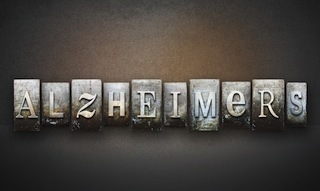 For today’s edition of Dear Mark, we’ve got just two questions, but they’re meaty ones. The first concerns a new study seeming to claim that all the foods we hold dear on the Primal eating plan — or at least a big portion of them — cause Alzheimer’s disease. Could it be true, or is the study, which is an epidemiological massage of existing data, maybe not quite so definitive as that? Also, what if we had a study showing that exact opposite: that following a Primal lifestyle (not just diet) could actually reverse Alzheimer’s-associated cognitive decline? Then, I discuss the role of competitiveness in life. Having been a top endurance athlete, I know a little bit about the subject. What does it mean these days, though?
For today’s edition of Dear Mark, we’ve got just two questions, but they’re meaty ones. The first concerns a new study seeming to claim that all the foods we hold dear on the Primal eating plan — or at least a big portion of them — cause Alzheimer’s disease. Could it be true, or is the study, which is an epidemiological massage of existing data, maybe not quite so definitive as that? Also, what if we had a study showing that exact opposite: that following a Primal lifestyle (not just diet) could actually reverse Alzheimer’s-associated cognitive decline? Then, I discuss the role of competitiveness in life. Having been a top endurance athlete, I know a little bit about the subject. What does it mean these days, though?
Let’s go:
I am a almost 67 year old man who has been following the primal eating and exercise plan for over a year. I have lost around 20 lbs in that time.
I am happy with my fitness and appearance.
In the press today a diet was published which allegedly can protect a person from Alzheimer’s. This diet is pretty much the opposite of Primal. Should I be worried?
Peter
I’m pretty sure you’re referring to the Mediterranean-DASH Intervention for Neurodegenerative Delay, or MIND diet. It has ten “brain-healthy” food groups and five “brain-unhealthy” food groups.
Healthy foods include:
Leafy greens
Other vegetables
Berries
Extra virgin olive oil
Beans
Fish
Poultry
Nuts
Wine
Whole grains
In the “unhealthy” category, we see:
Cheese
Red meat
Butter and margarine
Pastries and sweets
Fried and processed foods
If this were a dietary intervention study, I’d look a little harder at the diet. If the researchers had actually placed one group on the MIND diet and one on a normal diet, tracked them for twenty years, and noted the differences in Alzheimer’s disease rates, this would be a huge paper. But they didn’t do that. They analyzed what people in an existing data set were already eating. Which is fine, but it’s not the final word.
Whenever you look at these studies showing a particular food is associated with a particular disease state, you must remember the “healthy user effect.” The powers that be have proclaimed butter and beef to be supreme dietary evils, and those associations are etched into our collective subconscious. Because we’ve all grown up in a society where people “know” that “butter and red meat are terrible for you,” actual people who flout those rules tend to be careless eaters and lead generally unhealthy lives. They enjoy their beef and butter between two fried slices of white bread with a side of cigarette smoke and four hours of television. The closest they get to two servings of vegetables a day is fries and ketchup.
Conversely, the folks who eat the whole grains, the beans, the nuts, and other “universally-accepted as healthy” foods do other healthy things like exercise regularly, visit the outdoors, and never smoke. They usually reside in a higher socioeconomic bracket, which might be the healthiest lifestyle factor of all. And when researchers removed from analysis those people who changed their diets midway through the study to a “healthier” pattern, the association between MIND and protection from Alzheimer’s strengthened. If the MIND diet was primarily responsible for the favorable outcomes, switching to it from an unhealthier diet should have conferred greater protection, but only those who ate healthy from the start — the true healthy users — had significant protection. You have to wonder what other differences exist between lifelong MIND dieters and people who switched to MIND dietary patterns after a doctor recommended they do so.
The exclusion of red meat and butter do jump out at you. I get that. Aren’t they two foods that we lionize in the Primal Blueprint? Sorta. But we emphasize them so much because we’re opposing a paradigm that vilifies them and we must speak louder to be heard. And if you compare the two diets above, I’d actually suggest that the “brain-healthy” food groups are more Primal than not. I don’t know about you, but I eat leafy greens, other vegetables, berries, nuts, fish, poultry, and EVOO just about every single day. Wine, not as often lately, but I used to have a glass daily. In fact, those foods are just as crucial to a successful Primal eating plan (if not more so) as grass-fed beef and butter.
Besides, we do have a set of ten dietary and lifestyle intervention case studies where the diet and lifestyle look very familiar. This intervention was designed for reversal of Alzheimer’s-related cognitive decline, rather than prevention, but take a look at the main points:
Eliminate all simple carbs and follow a low-glycemic, low-grain (especially refined grains) diet meant to reduce hyperinsulinemia.
12 hour eating window, 12 hour fast each day.
Stress reduction (yoga, meditation, whatever works for the individual).
8 hours of sleep a night (with melatonin if required).
30-60 minutes of exercise 4-6 days per week.
Brain stimulation (exercises, games, crosswords).
Supplementation to optimize homocysteine, vitamin B12, CRP levels.
Take vitamin D and vitamin K2.
Improve gut health (prebiotics and probiotics).
Eat antioxidant-rich foods and spices (blueberries, turmeric).
Optimize hormone balance (thyroid panel, cortisol, pregnenolone, progesterone, estrogen, testosterone).
Obtain adequate DHA to support synaptic health (fish oil, fish).
Optimize mitochondrial function (CoQ10, zinc, selenium, other nutrients).
Use medium chain triglycerides (coconut oil, MCT oil).
That’s crazy talk! Eat a low-grain, low-glycemic (which usually, but not always, means lowish-carb) diet? Go a little hungry sometimes? Manage your stress? Get enough sleep and exercise? Use your brain on a regular basis? Use smart supplementation of key nutrients missing from your normal diet? Feed your gut flora and take probiotics when needed? Eat colorful produce? Recognize that hormones affect and effectively control health? Seafood is healthy and important for brain function? Mind your mitochondria? Keep inflammation at bay? Medium chain triglycerides can have special effects on the brain?
What kind of a fool would think making these modifications to one’s diet and lifestyle would make a difference to cognitive function, especially in the context of Alzheimer’s disease? Dale Bredesen, the MD responsible for these ten patients and the author of the case studies, for one. Nine out of ten subjects who entered the intervention program displayed subjective and/or objective improvements in cognitive function. Of the six subjects who’d been previously forced to stop working due to loss of function, all six were able to return to work after the intervention.
I want to reiterate: I’m not ruling out beef and butter playing a role in Alzheimer’s pathogenesis, at least in certain genetically susceptible individuals. Maybe going Primal gives you Alzheimer’s then somehow reverses it. That’d be odd, but who knows?
Also, the case studies are just that: a group of case studies. They’re also not the final word, but they do start the conversation. To confirm that the dietary and lifestyle interventions actually do reverse cognitive decline, we’d need trials with larger cohorts. And that would get very expensive very quickly due to the complexity of the interventions.
If you’re still worried, Peter, don’t be. Look at the MIND diet, the cognitive decline intervention guidelines, and the Primal Blueprint Laws and notice the commonalities. All eliminate junk food, sweets, and deep fried food, the worst offenders in any diet. All emphasize low-carb colorful berries, vegetables, healthy oils, seafood, and nuts. Then, notice that the latter two emphasize far more than just diet. I guess if there’s one takeaway from all this it’s that diet isn’t enough. You can’t just eat Primal and get away scot free. To get the full benefits, you really have to embrace the entire lifestyle — or as much as you can integrate.
Mark!
Would you be willing to discuss the topic of competitiveness? I guess it’s fairly obvious where the trait comes from considering survival of the fittest and all. But since most of us reading this blog have our basic needs met, what role should competitiveness play in the life of a Primal adult?
Thanks man. Your stuff knocks me out
Lauren C.
Hey, Lauren, thanks for the kind words. That really means a lot to me.
A competitive spirit has its good and bad sides.
I’m a natural competitor, a real type A personality. That’s what drove me to compete in the marathon and then, when I couldn’t do that anymore, triathlon for so many years despite my body giving up on me and my quality of life in tatters: I always wanted to beat the other guys. I wanted to be the best. And not necessarily a better me, but a “better than him.” You need that competitive drive to block the pain, or endure it when you can’t block it out anymore. Your desire, your need to beat the competition has to outweigh the subjective discomfort. It’s the only way to succeed in an intrinsically unpleasant event like the marathon or Ironman. It helped me win races and improve performance (good) but it also made me push past my body’s breaking point and ultimately burned me out on the sport (bad).
And of course, I can’t turn it off even if I’m no longer competing in an official capacity. My weekly Ultimate Frisbee games are friendly, but I take them really seriously and find the vociferousness with which I bump opponents’ shoulders has an inverse relationship to the scoring margin.
For the average person, having competitiveness can act as a reminder that you’re still kicking. That you still care about improving yourself and performing well at whatever it is you do. What you do doesn’t really matter as long as you can improve and maybe measure your performance against others. It could be work, or rec league basketball, or strength training, or art. Whatever works and makes you feel alive.
Just try to keep the competition friendly. Don’t give up or relent or anything like that, mind you. Just don’t let your emotions take over and make you do something you’ll regret later. Be courteous and kind toward the competition even as you attempt to be better than it. This type of friendly competitiveness continues to serve me in my business. I’m not just trying to outdo my own accomplishments, I’m trying to produce the best blog, books, supplements, and so on, that are available. That’s what you have to do to be good. Of course, many of the people I’m “up against” are my friends and colleagues. And they’re doing the same with me. Even as we help each other out and provide support and resources, we’re still engaged in friendly competition.
That’s it for today, everyone.
Are you worried about the first Alzheimer’s study? Motivated by the second? What role does competitiveness play in your modern life?
Let’s hear down below and thanks for reading!




April 12, 2015
Weekend Link Love – Edition 343
 We’re starting another round of The 21-Day Transformation Challenge on the Vimify app, Monday, April 13th! Whether you’re new to the program, you want to recommit, or you just need a challenge, now’s the time!
We’re starting another round of The 21-Day Transformation Challenge on the Vimify app, Monday, April 13th! Whether you’re new to the program, you want to recommit, or you just need a challenge, now’s the time!
Research of the Week
In type 2 diabetics, a high-egg diet had no adverse effect on cardiovascular risk factors, and it improved satiety.
Night owls are more likely to have metabolic syndrome than morning people.
Muscle mass: the best predictor of all-cause mortality risk in older men. Body fat? Doesn’t matter so much.
While their counterparts to the south relented, Northern European hunter-gatherers strongly resisted the spread of farming.
New Primal Blueprint Podcasts

Episode 62: Listener Questions and Answers with Mark Sisson: First, Brad and I sit down to catch up on the latest news from Primal Blueprint headquarters, including the successful launch of the Primal Blueprint Expert Certification program and Primal Kitchen Mayo, plus the upcoming releases from Primal Kitchen and Primal Blueprint Publishing. Then, we go through reader questions and cover a range of topics including insulin resistance on a low-carb diet, the best time to take supplements, why cold water plunges help, weight gain and metabolic slowdown in winter, the dangers of endless snacking, and more.
Each week, select Mark’s Daily Apple blog posts are prepared as Primal Blueprint Podcasts. Need to catch up on reading, but don’t have the time? Prefer to listen to articles while on the go? Check out the new blog post podcasts below, and subscribe to the Primal Blueprint Podcast here so you never miss an episode.
How to Take Care of Your Gut: The New and Improved Primal Flora
Do You Value Experiences Over Things?
7 Ways You Might Be Inadvertently Sabotaging a Good Night’s Sleep
The Definitive Guide to Resistant Starch
Self-Control: The Ultimate Exercise of Freedom
Interesting Blog Posts
No, not all diets fail.
Do you still have to brush and floss if you’re paleo?
I didn’t think I’d ever hear the phrase “a strength and conditioning Cormac McCarthy,” but I’m sure glad I did.
Media, Schmedia
An interesting interview with Dr. Alessio Fasano, the celiac/leaky gut/autoimmune disease expert.
A Colorado startup is using mushrooms to make gluten-free wheat.
Is dieting antithetical to feminism?
Everything Else
New research confirms the veracity of a 30,000 year-old Aboriginal legend, preserved solely through the oral tradition, about the origin of palm trees in Australia.
Staple foods in many countries are contaminated with aflatoxin, and it could be affecting children’s growth.
More kids (this time, in Marin County) are getting standing desks at school. The revolution continues apace.
April Fools has passed, but this is still pretty funny.
Lovely set of teeth you’ve got there, 2-million-year-old Homo habilis from Kenya.
Sea shells are way more gorgeous than we’ve been led to believe.
Recipe Corner
Spiralized sweet potato latkes. Gotta admit, they look pretty good.
If you can get your hands on really fresh fish, make this ceviche.
Time Capsule
One year ago (Apr 13 – Apr 19)
4 Foods That Have Surprising Medicinal Benefits – Are you eating these foods? Why not?
You Are What You (Think You) Eat –The placebo effect applies to the food we eat, too.
Comment of the Week
“Something weird is happening, and I want it to be happening to me” -Zaphod
One of my favorite quotes from a Douglas Adams book. Experiences are absolutely more valuable than things (although consumer electronics are a close second). Even if that experience sucks at the time, it will eventually be of more value to you than your awesome collection of Fast and Furious movies on Blu-Ray.
– Anyone who quotes Zaphod Beeblebrox gets Comment of the Week.




April 11, 2015
Primal Chinese Orange Chicken
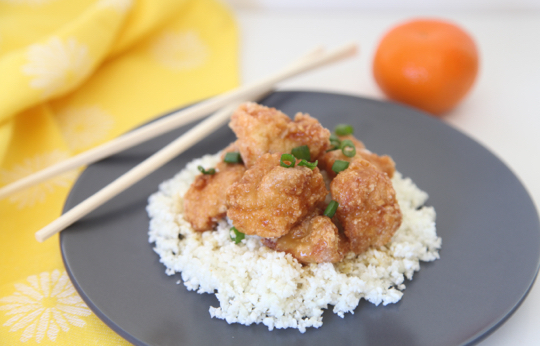 Orange chicken probably needs no introduction, but for those of you who have never ordered from a Chinese-American take-out menu, it’s battered and deep-fried chicken pieces coated in a sticky, sweet orange sauce. Health food, it is not. But sometimes, it’s surprisingly easy to transform a recipe from something SAD into something deliciously Primal.
Orange chicken probably needs no introduction, but for those of you who have never ordered from a Chinese-American take-out menu, it’s battered and deep-fried chicken pieces coated in a sticky, sweet orange sauce. Health food, it is not. But sometimes, it’s surprisingly easy to transform a recipe from something SAD into something deliciously Primal.
This Primal Chinese Orange Chicken recipe takes what’s good about Orange Chicken (crispy morsels of chicken and a sweet, tart, spicy sauce) and leaves out what’s bad (flour, cornstarch, canola oil, sugar). The orange sauce – made mainly from freshly squeezed orange juice, coconut aminos and rice vinegar – is so good that it makes a person wonder why sugar is ever added in the first place. And the bits of chicken – tender in the middle with a substantial, battered coating – are the type of thing you’ll be popping in your mouth before they have a chance to hit your plate.
Servings: 4
Time in the Kitchen: 1 hour
Ingredients:
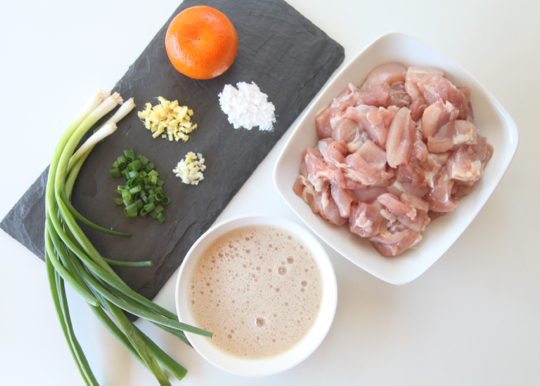
6 boneless, skinless chicken thighs, cut into 1-inch pieces
1 cup tapioca flour (120 g)
¾ teaspoon kosher salt (3.7 ml)
2 egg whites
2 teaspoons plus 2 tablespoons coconut aminos, divided (10 ml plus 30 ml)
¼ teaspoon toasted sesame oil (1.2 ml)
1 garlic clove, finely chopped
3 teaspoons finely chopped ginger (15 ml)
½ cup freshly squeezed orange juice (120 ml)
3 teaspoons unseasoned rice vinegar (15 ml)
¼ teaspoon red pepper flakes (1.2 ml)
1 tablespoon orange zest (15 ml)
2 cups cold-pressed high-oleic/high-stearic sunflower oil (for frying – depending on the size of the pot, you may need more or less than 2 cups)
2 green onions, chopped (475 ml)
Instructions:
In a medium bowl, mix together the tapioca flour and salt. Set aside.
In a large bowl, whisk together egg whites and 2 teaspoons/10 ml of the coconut aminos until frothy. Add the chicken pieces to the bowl. Mix well so the chicken is well coated. Set aside.
To make the sauce, heat the sesame oil in a small pot and sauté the garlic and ginger for 1 to 2 minutes, being careful not to let the garlic burn. Add orange juice, remaining 2 tablespoons/30 ml of coconut aminos, rice vinegar, and red pepper flakes. Bring the sauce to a gentle boil and keep on the heat until the sauce reduces and thickens into a syrupy consistency, 3-5 minutes.
Pour the sauce through a fine mesh strainer to separate (and discard) the bits of garlic and ginger. Stir in the orange zest. Set the sauce aside.
Use a fork or slotted spoon to scoop the chicken pieces out of the egg whites and into a clean bowl, leaving behind any of the egg white liquid that isn’t clinging to the chicken.
Transfer 1/3 of the chicken into the bowl of tapioca flour and toss to coat. Spread the coated chicken out on a large plate. Continue to add the remaining chicken to the tapioca flour in small batches until it is all coated.
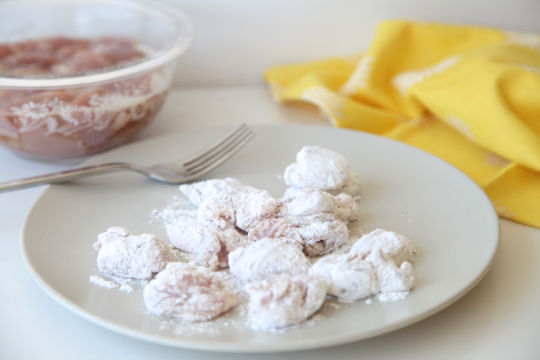
In a deep, heavy pot, heat the sunflower oil. You’ll want about 2 inches/5 cm of oil for frying. The oil should be very hot and glistening (and at around 350 ºF/177 ºC). Test the oil temperature by tossing in a tiny piece of chicken; it should bubble and fry immediately.
In small batches, carefully drop pieces of chicken into the oil one-by-one so the pieces don’t stick together. Move and turn the chicken around a few times as it cooks, so it browns evenly. Fry each piece for about 3 minutes or until golden.
Remove each batch of chicken from the oil and set aside. When all the chicken is fried, drizzle the orange sauce on top. Serve alone, garnished with green onions, or on top of cauliflower rice.

Not Sure What to Eat? Get the Primal Blueprint Meal Plan for Shopping Lists and Recipes Delivered Directly to Your Inbox Each Week



April 10, 2015
No Freshman 15 for This Guy!
It’s Friday, everyone! And that means another Primal Blueprint Real Life Story from a Mark’s Daily Apple reader. If you have your own success story and would like to share it with me and the Mark’s Daily Apple community please contact me here. I’ll continue to publish these each Friday as long as they keep coming in. Thank you for reading!
 I remember my senior year of high school before deciding to go Primal. I went to a small high school just outside of Milwaukee, Wisconsin, and was a two time state qualifier in track in field for the 4×200 meter relay. I ran sprints in track in the spring, and ran cross country in fall to stay in shape and work on running form. As you can guess with all this constant working out (especially in cross where I was running an average of 3-5 miles per practice, averaging close to 30 miles per week), I was a carb hound! On average, I was probably consuming about 500 grams of carbs and consuming close to 4000 calories daily, consisting of 95% junk foods like pastas, cookies, ice cream, sandwiches, and all the other artificial foods you can think of.
I remember my senior year of high school before deciding to go Primal. I went to a small high school just outside of Milwaukee, Wisconsin, and was a two time state qualifier in track in field for the 4×200 meter relay. I ran sprints in track in the spring, and ran cross country in fall to stay in shape and work on running form. As you can guess with all this constant working out (especially in cross where I was running an average of 3-5 miles per practice, averaging close to 30 miles per week), I was a carb hound! On average, I was probably consuming about 500 grams of carbs and consuming close to 4000 calories daily, consisting of 95% junk foods like pastas, cookies, ice cream, sandwiches, and all the other artificial foods you can think of.
 Prior to going Primal, I had an extensive history of muscle injuries and joint issues. I tore or strained every leg muscle you can think of, from tearing my hip flexor, to having strained my quad so severely my knee would swell to the point where I could barely straighten my leg. My joints were constantly stressed and ached occasionally. I will never forget when I had my physical before cross country season my senior year, and my doctor told me I had knee joints equivalent to that of a 40 year old marathoner. You can imagine I was pretty disturbed as an 18 year old being told this. Outside of muscles and joints, I was also a victim of some pretty nasty acne, particularly around my chin and mouth area. It was not fun walking around high school and just thinking what people thought of you when they noticed all the red, white tipped bumps on your face! Emotionally I was also very distraught. I used to have mood swings regularly, and such a short temper, I used to go off on people even when they were trying to help me. I was pretty messed up to say the least. It was not until after cross country season of my senior year in high school my brother Tony (on the right, in the photo) introduced me to MDA, and Wheat Belly by Dr. William Davis.
Prior to going Primal, I had an extensive history of muscle injuries and joint issues. I tore or strained every leg muscle you can think of, from tearing my hip flexor, to having strained my quad so severely my knee would swell to the point where I could barely straighten my leg. My joints were constantly stressed and ached occasionally. I will never forget when I had my physical before cross country season my senior year, and my doctor told me I had knee joints equivalent to that of a 40 year old marathoner. You can imagine I was pretty disturbed as an 18 year old being told this. Outside of muscles and joints, I was also a victim of some pretty nasty acne, particularly around my chin and mouth area. It was not fun walking around high school and just thinking what people thought of you when they noticed all the red, white tipped bumps on your face! Emotionally I was also very distraught. I used to have mood swings regularly, and such a short temper, I used to go off on people even when they were trying to help me. I was pretty messed up to say the least. It was not until after cross country season of my senior year in high school my brother Tony (on the right, in the photo) introduced me to MDA, and Wheat Belly by Dr. William Davis.
My brother Tony had started living Primal about a year before me, and had lost a significant amount of weight (close to 50 lbs), and reversed his pre-diabetic symptoms. I remember my cross country coach saying how much you need carbs, and when Tony first started his diet, I criticized him at first saying he was nuts! Well I was the nuts one later when I found out after reading The Primal Blueprint, MDA articles, and Dr. Davis’s work about all the information nutritionists, doctors, and health professionals fail to mention when they meet with you, and how entirely backwards they have their recommendations. Needless to say my eyes were opened, and I was ready to make a change for the better.
It was a difficult transition for me to go Primal in some sense. My parent’s pantry and fridge was, and still consists of mostly wheat and sugar based foods as they refuse to change over. I’m still working on changing that. So, as you can imagine, I was like what am I supposed to eat?! Well at the time, I was working as a produce clerk at the local grocery store. I was around fruits and vegetables all day, so I decided to start seeing what tasted good to me. Prior to this, I had never tried spinach, romaine lettuces, kale, and all these delicious nutrient rich substances that were always around me. I started making myself salads at work, eating berries, apples, oranges, and bananas when I had the daily sugar cravings, instead of a bag of gummi bears.
The first time I tried a salad at work, I’m not going to lie, I wanted to put some ranch on the lettuce and some ketchup on the chicken to sweeten it up, but I stuck it out. It felt like I was quitting smoking, as I had crazy cravings for the remainder of the week for sugar.
Eventually though, about five days after starting this new eating style, I found myself getting up one morning with a big surprise. My knees would normally ache when I would get out of bed in the morning, and this was no longer the case. I thought to myself, no way. No knee pain! This was the first change I noticed, and I still remember that moment every time I wake up now. As my new eating style continued, my acne began to go away quickly, my teeth started becoming whiter and cleaner, and my mood swings had majorly improved to the point where I no longer have them. I fortunately have never had a weight problem. I have been 150 pounds since I was 16. Soon after though, I began to notice more toning of my muscles, now that my body could properly metabolize protein more efficiently. I started being able to work out, and run freely without worrying about my leg muscles tearing apart on me, and I got back to enjoying fast paced sports once again. Things were definitely changing for the better, and I was daily (sometimes hourly) going on MDA to keep learning about all the health questions popping into my head.
I was always around a 3.7 gpa in school, so I was above average, but by no means a genius. Once going Primal, I started noticing changes in how much clearer I was able to think. I used to daily come to class with a foggy conscious, and could barely stay awake during instruction. This was no longer the case as I was much more alert, able to focus much longer, and engage in subject material.
 A year later now, I am graduated from high school and a freshman in college at a small engineering school in Milwaukee, WI. There are so many opportunities to gorge in endless pizza slices, greasy hamburgers, and all that other college food most of you are aware of. I avoid these foods like a hazard, and everyone looks at me all the time because of all the vegetables I snag from the salad bar. I typically don’t eat a breakfast as I honestly do not have hunger in the morning. Most of the time, I just grab a bottle of water on my way to class until lunch. My lunch often consists of a full plate of greens with usually a couple pieces of baked chicken, pork, beef and other entrée’s. Dinner is usually the same kind of food as lunch. I keep fruit in my dorm room, along with some nuts, almond butter, and some cheese to snack on in case I get sugar cravings. I never imagined myself eating the way I do as I never tried any type of eating beside the carbohydrate binges suggested by the National Institute of Health’s food pyramid. You know, the one with the suggested 11-12 servings of grains per day. Never going back to CW. Going Primal is, and from here on out will be the way I live my life.
A year later now, I am graduated from high school and a freshman in college at a small engineering school in Milwaukee, WI. There are so many opportunities to gorge in endless pizza slices, greasy hamburgers, and all that other college food most of you are aware of. I avoid these foods like a hazard, and everyone looks at me all the time because of all the vegetables I snag from the salad bar. I typically don’t eat a breakfast as I honestly do not have hunger in the morning. Most of the time, I just grab a bottle of water on my way to class until lunch. My lunch often consists of a full plate of greens with usually a couple pieces of baked chicken, pork, beef and other entrée’s. Dinner is usually the same kind of food as lunch. I keep fruit in my dorm room, along with some nuts, almond butter, and some cheese to snack on in case I get sugar cravings. I never imagined myself eating the way I do as I never tried any type of eating beside the carbohydrate binges suggested by the National Institute of Health’s food pyramid. You know, the one with the suggested 11-12 servings of grains per day. Never going back to CW. Going Primal is, and from here on out will be the way I live my life.
I hope from reading my experience parents, especially parents with kids in college, encourage Primal style living at home with your kids. My grades, my physical/mental state, and my life has never been better and more enjoyable. I am in great shape consistently working out two to three times a week for about an hour each time. No freshman 15 to worry about, very thankful for that. Family life is much more enjoyable now I am not the kid who would come home in a different mood each day. This lifestyle did not just change the way I eat, it changed my life!
A special thanks once again to my brother Tony, and his friend Dave who got Tony started going Primal. Without them, I would not be where I currently sit.
Grok on, everyone!
Neil




Mark Sisson's Blog
- Mark Sisson's profile
- 199 followers




